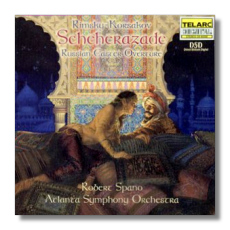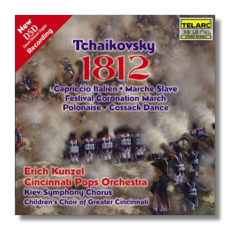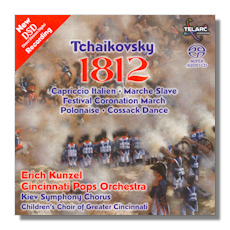
The Internet's Premier Classical Music Source
Related Links
-
Rimsky-Korsakoff Reviews
Tchaikovsky Reviews - Latest Reviews
- More Reviews
-
By Composer
-
Collections
DVD & Blu-ray
Books
Concert Reviews
Articles/Interviews
Software
Audio
Search Amazon
Recommended Links
Site News
 CD Review
CD Review
Orchestral Fireworks

Nicolai Rimsky-Korsakoff
- Schéhérazade
- Russian Easter Overture
Atlanta Symphony Orchestra/Robert Spano
Telarc CD-80568 DDD 60:02


Piotr Ilyitch Tchaikovsky
- 1812 Overture
- Capriccio Italien
- Marche Slave
- Eugene Onegin: Polonaise and Waltz
- Festival Coronation March
- Mazeppa: Cossack Dance
Kiev Symphony Chorus
Children's Choir of Greater Cincinnati
Cincinnati Pops Orchestra/Erich Kunzel
Telarc CD-80541 DDD 60:23
Also released on Hybrid Multichannel SACD SACD-60541:
Amazon
- UK
- Germany
- Canada
- France
- Japan
- ArkivMusic
- CD Universe
- JPC
Robert Spano became Music Director of the Atlanta Symphony Orchestra in the 2000-01 season. This is his first recording with the Orchestra, and, on the basis of this CD, the Atlantans remain in good hands. Telarc can rest easy knowing that it will continue to make fine recordings in that city's Symphony Hall under Maestro Spano's direction.
Seiji Ozawa appointed Spano, a pupil of Robert Baustian and Max Rudolf, to serve as Assistant Conductor of the Boston Symphony Orchestra in 1990. He has distinguished himself in the United States, Europe, Australia, and Japan as a conductor of both orchestral works and opera. His programs with the Brooklyn Philharmonic Orchestra, where he has been the Music Director since 1996, are notable for their intelligence and originality. Spano, like Benjamin Zander (another fairly recent Telarc signee), seems poised to succeed in a prominent, international conducting career, and Telarc is fortunate to have him on its roster right now.
For a work recorded as many times as Schéhérazade, it would be asking too much to expect Spano to wipe away his predecessors. He doesn't - Beecham, Stokowski, Bernstein, Karajan, and Ormandy (to name just five) remain justifiable favorites in this colorful score. Still, Spano's recording has many virtues and few weaknesses. He dramatically contrasts Rimsky's music for the murderous Sultan Shahriar with the beguiling, gentle violin solos that represent that work's eponymous heroine. (Violinist Cecylia Arzewski is appropriately feminine in this "role.") His interpretation is exciting, particularly in the final movement, which turns into a dull maelstrom of rhetoric on other recordings. Telarc's DSD (Direct Stream Digital) recording is state of the art, and it is especially nice to hear that violin solos in their proper orchestral perspective, neither magnified nor inflated by the engineers. There were times, however, when I thought Spano's phrasing could have been more fluid; he's sometimes unwilling to relax and let the music unwind. Interpretively, his is a middle-of-the-road reading in the best possible way, yet there were a few raised-eyebrow moments. For example, at the Allegro non troppo in the first movement when Sinbad's vessel gets under way, Spano's aggressive emphasis had me momentarily losing my balance on the ship's stern. The Russian Easter Overture, which brings the CD just over the one-hour mark, is a strong performance - again, not one to efface old favorites, but one that gives pleasure as a product of the modern age.
With the Tchaikovsky CD, Telarc repeats history. It was in the late 1970s when the label released Kunzel's first 1812, and a whole new era of sound reproduction was born, thanks to cannon-fire that could blow you out of your living room and into next week. Today, Telarc has DSD technology, and it also has DVD-Audio and Super Audio CD (SACD); this disc being released in all three media. Only time will tell whether the advent of these two new media is as important as the advent of digital sound itself in the 1970s.
Unsurprisingly, this is an all-stops-out 1812. The Kiev Symphony Chorus sings the Czarist hymn at the beginning and the end, and an American children's chorus sings the folk-like tune that appears twice in the middle of the Overture. Bells from the Church of the Covenant in Cleveland (recorded in various perspectives, to create the effect of multiple carillons) appear at the end. Cannon shots? Producer Robert Woods probably would look hurt if you thought otherwise. The Civil War-era cannons were fired and recorded on the lawn outside the Blossom Music Center; the cannons and microphones were arranged to create, in the words of Recording Engineer Michael Bishop, "Cannons in 360 degrees." To me, the most remarkable thing about this recording is that the orchestra, choruses, bells, and cannons were recorded at separate sessions, edited, and mixed together ex post facto.
Given its picture puzzle like assembly, this recording could have been dead before it marched out onto the battlefield. Instead, this is an exciting and very musical 1812 Overture. The effects make it all the more thrilling, but they never detract from the musicianship itself, which is solid. The choruses sing lovingly, and the Cincinnati Pops plays the work as if they haven't played it dozens of times already. Although the famous Telarc warning about not turning the volume up until you determine safe playback levels for your equipment needs to be heeded, the effects should be enjoyably reproducible on any stereo. Even better, the remaining items on the disc are not just filler. Kunzel plays them with genuine panache, and his Marche Slave ranks up there with the best of them. Sonically and musically, this is a wonderfully enjoyable CD, and I congratulate everyone involved for achieving the impossible… a second time.
Copyright © 2001, Raymond Tuttle






















